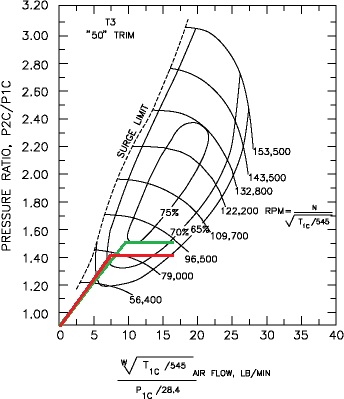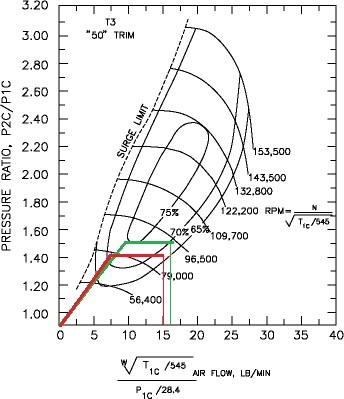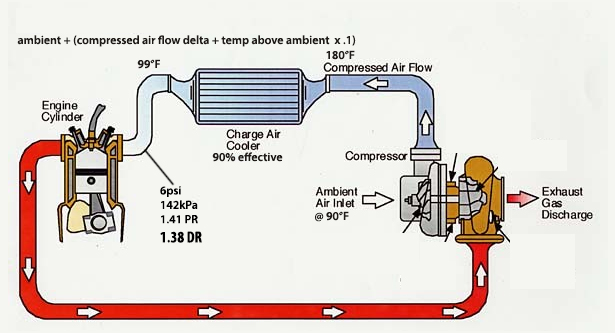Is cold air intake necessary on a turboed car?
#61
All I changed on the diagram was delta T heat transfer efficiency, and I guessed the percentage.
Like you, I'm just trying to show everyone that there is more too it.
Unlike you, I feel that the difference on a low boost setup like most here run, is negligible.
I was using heat transfer efficiency with increased delta t as my main reason for this opinion (outside of dyno results).
Dann
Like you, I'm just trying to show everyone that there is more too it.
Unlike you, I feel that the difference on a low boost setup like most here run, is negligible.
I was using heat transfer efficiency with increased delta t as my main reason for this opinion (outside of dyno results).
Dann
Last edited by nitrodann; 03-15-2015 at 10:16 PM.
#62
The next revision will likely involve moving the oil catch can and routing as large of pipe as possible alongside the intercooler and mounting a "securely mounted" filter accessing the side of my radiator inlet shrouding.
It has been interesting reviewing the math. Thx!


Last edited by speedj; 03-16-2015 at 06:29 PM.
#63
Boost Czar


iTrader: (62)
Join Date: May 2005
Location: Chantilly, VA
Posts: 79,493
Total Cats: 4,080
I didnt take physics in HS, I took it it college, and my extent on heat transfer was dropping ice into coffee and measuring the temps vs. time.
how about this caveat: assume the IC is working at full efficiency throughout the rpms--and that's 90% regardless.
because there's still a lot more to it than that: Front Mount Intercooler Efficency Test Data
how about this caveat: assume the IC is working at full efficiency throughout the rpms--and that's 90% regardless.
because there's still a lot more to it than that: Front Mount Intercooler Efficency Test Data
#67
All I changed on the diagram was delta T heat transfer efficiency, and I guessed the percentage.
Like you, I'm just trying to show everyone that there is more too it.
Unlike you, I feel that the difference on a low boost setup like most here run, is negligible.
I was using heat transfer efficiency with increased delta t as my main reason for this opinion (outside of dyno results).
Dann
Like you, I'm just trying to show everyone that there is more too it.
Unlike you, I feel that the difference on a low boost setup like most here run, is negligible.
I was using heat transfer efficiency with increased delta t as my main reason for this opinion (outside of dyno results).
Dann
To me, this is the best way to tackle this problem.
....
As far is pre turbo inlet pipe and any losses there, I think the main thing you can do is have a short and smooth transition to the inducer inlet. Smooth bends and gentle transitions in diameter. If you turbo inlet is say 2.5 inch, make sure all cross sectional areas up stream are at least 2.5 in.
#72
Pretty much everyone in this thread has posted incorrect information about thermodynamics and heat transfer. Makes sense, not everyone here is formally educated in these subjects.
Rather than getting in a pissing match, why don't you guys grab a beer or something? Find a noob to rip a new one...anything is more productive than this thread.
18psi's post #5 sums things up effectively. Without data, everything else is just a shot in the dark anyways.
Patrick: Your math completely checks out. What your missing is what Scott is trying to tell you. Your boost control setup equalizes out the large differences you are speaking of. If your wastegate is referenced after the intercooler, and your intercooler isn't undersized, your motor doesn't give a **** what happened at the compressor outlet. It just has air at your target boost, at a temperature not much higher than ambient. With P and T, your equation of state for the air is basically fixed, and your power level will be slightly less than the CAI, but decently close.
The biggest assumption here is the post-intercooler wastegate reference. If your reference is between the compressor outlet and intercooler, you will see much larger power drops when not running a CAI.
I can tell you, without a doubt, that a CAI turbo car will reach target boost at a lower RPM than a non-CAI car, with all else being equal. Before that wastegate opens, the CAI car has the advantage for sure. How much earlier will you see target boost? I have no idea. My guess would be a few hundred RPM.
Dann: You need to chill out, there is no need to be so damn insulting. Scott has the big picture here, even if some details aren't spot on, but he admitted that, so I see no reason to act like this. Yes, you understand heat exchanger efficiency a little better. But then you linked some page that just talks about conduction. An intercooler's predominant heat transfer comes from convection, then from radiation, and absolutely last comes conduction.
This is not high school level physics we are talking about. What's funny is that when you say the low boost setups will not benefit a ton from a CAI, you and Scott are basically agreeing.
Leafy: Props given for stating that you need to go to metric units for thermodynamic or fluid dynamics problems. While technically equivalent, metric seems to be less confusing for some reason. If you are dealing with Temperature in the Rankine scale, you have already lost the battle. This is a personal opinion, but I have broken many test curves because I always convert these type of problems to metric first.
#76
 Just pointed out his error and kindly explained why a CAI is important and not trivial. Apparently the word trivial has different meanings or nobody understands what I write.
Just pointed out his error and kindly explained why a CAI is important and not trivial. Apparently the word trivial has different meanings or nobody understands what I write.Here's a funny things I'll just point out. You guys can read it and just think about it. I'm not going to explain the same thing 20 times and be told I'm wrong when I'm not.
Like you said dustin, a CAI will make the turbo spool faster. Why?
Answer: For the reasons I have explained. When the turbo is "spooling" it doesn't' have enough HP from the turbine yet. So if it's spooling faster with a CAI, that's because the compressor is more efficient. Notice I never said a word about intercooler?
Also regarding data, yes, it's needed to be exact. I said that in my first post! But math (real math, with all the variables accounted for, not just some) is still correct, and you can work some examples and see how changing one things affects a temp or pressure, etc.
#77
Boost Czar


iTrader: (62)
Join Date: May 2005
Location: Chantilly, VA
Posts: 79,493
Total Cats: 4,080
To be fair to Dann, I have been an *** to him. But I did politely bow out and admit I was wrong in our TQ discussion. I was thinking about total load, but not distinguishing between compressive and tensile, which was a mistake.
I don't doubt this at all. I've suggested the same. But I believe it's going to look more like this between the two plots:

The turbo will have to spin faster and at a higher PR to provide the same amount of oxygen after IC. So it might spool up a tiny bit slower, plus the extra time it takes to reach boost threshold, but ultimately it's still in the same heat efficiency.
FWIW, using the math formula on the compressor map, we can correct the airflow for temperature. This makes me assume (sorry Dan) that the heat efficiency island does not change, but the flow rates around it do.
for example on the above compressor map:
it's been measured at at 85°F inlet temps and 13.949psi. So for my 90° day, lets just call that one close enough.
but we can correct the airflow for the 180°F inlet temps.
So say we need 15 lb/min then:
corrected flow = required airflow x (new temp/545R)^0.5 / (new / old pressure)
corrected flow = 15 x (640/545)^0.5 / 1
corrected flow = 16.5 lb/min
which looks more like this:

yes, like you said, there will be greater airflow requirements, but I still don't believe it's anywhere near where you're suggesting. There will be less area under curve, for sure, and less peak numbers, but I thinking if you plotted the two conditions on a dyno the difference wouldn't be that extreme. Which would be the better of the two? cold air, hands down, without a doubt.
But this thread was to discuss if a CAI is necessary and I honestly wanted to discuss that. I absolutely willing to concede if I find I'm wrong, but I'm still unable to at this point.
Here's a funny things I'll just point out. You guys can read it and just think about it. I'm not going to explain the same thing 20 times and be told I'm wrong when I'm not.
Like you said dustin, a CAI will make the turbo spool faster. Why?
Answer: For the reasons I have explained. When the turbo is "spooling" it doesn't' have enough HP from the turbine yet. So if it's spooling faster with a CAI, that's because the compressor is more efficient. Notice I never said a word about intercooler?
Like you said dustin, a CAI will make the turbo spool faster. Why?
Answer: For the reasons I have explained. When the turbo is "spooling" it doesn't' have enough HP from the turbine yet. So if it's spooling faster with a CAI, that's because the compressor is more efficient. Notice I never said a word about intercooler?

The turbo will have to spin faster and at a higher PR to provide the same amount of oxygen after IC. So it might spool up a tiny bit slower, plus the extra time it takes to reach boost threshold, but ultimately it's still in the same heat efficiency.
FWIW, using the math formula on the compressor map, we can correct the airflow for temperature. This makes me assume (sorry Dan) that the heat efficiency island does not change, but the flow rates around it do.
for example on the above compressor map:
it's been measured at at 85°F inlet temps and 13.949psi. So for my 90° day, lets just call that one close enough.
but we can correct the airflow for the 180°F inlet temps.
So say we need 15 lb/min then:
corrected flow = required airflow x (new temp/545R)^0.5 / (new / old pressure)
corrected flow = 15 x (640/545)^0.5 / 1
corrected flow = 16.5 lb/min
which looks more like this:

yes, like you said, there will be greater airflow requirements, but I still don't believe it's anywhere near where you're suggesting. There will be less area under curve, for sure, and less peak numbers, but I thinking if you plotted the two conditions on a dyno the difference wouldn't be that extreme. Which would be the better of the two? cold air, hands down, without a doubt.
But this thread was to discuss if a CAI is necessary and I honestly wanted to discuss that. I absolutely willing to concede if I find I'm wrong, but I'm still unable to at this point.
Last edited by Braineack; 03-17-2015 at 07:48 AM.
#80
So, the take away answer from my original question is: If I can't get air from a cold source, then at least have an appropriately sized, and properly ducted high efficiency intercooler to deal with the heating issues. Expect to be down on power due to heatsoak issues at the end of your rungroup session, especially on hot days.












